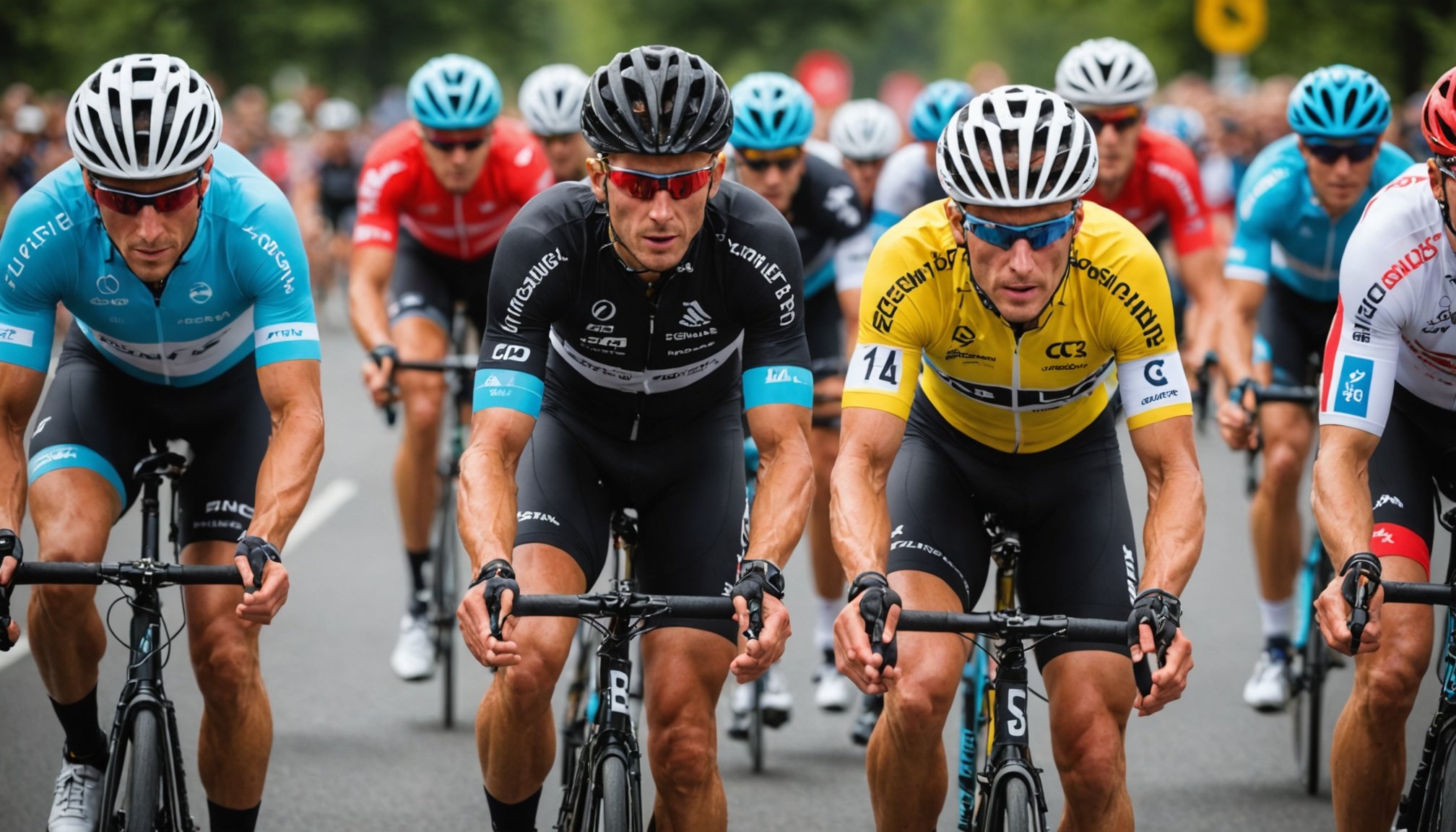Understanding Endurance Training for Cyclists
Endurance training is crucial for enhancing cycling performance, particularly in multi-stage competitions where prolonged stamina is key. It focuses on the body’s aerobic capacity, allowing cyclists to sustain activity over extended periods. Unlike strength training, which concentrates on muscle power, endurance training emphasizes cardiovascular efficiency and muscular endurance.
Physiological adaptations resulting from endurance training include increased aerobic capacity, enhanced cardiovascular efficiency, and improved fatigue resistance. These changes enable cyclists to maintain higher speeds for longer durations, leading to better overall performance in competitive scenarios. By routinely engaging in endurance workouts, cyclists develop a stronger heart and more efficient lungs, directly impacting their performance.
Have you seen this : Famous golfers who love gambling: a hole-in-one for bets!
Understanding these differences is vital when tailoring training programs. While both forms of training are essential for well-rounded development, balancing them according to individual goals can significantly boost results. Cyclists aiming for success in multi-stage competitions should prioritize endurance training. This approach will emphasize aerobic conditioning and physiological adaptations crucial for sustained performance. Implementing a structured endurance regime helps in achieving cycling goals, empowering cyclists to excel in dynamic competitive environments.
Proven Training Techniques
Implementing cycling training techniques effectively can significantly enhance a cyclist’s capability. Among these, endurance workouts, such as long-distance rides and interval training, play a pivotal role. These methods not only bolster stamina but also improve overall performance, paving the way for cyclists to excel in demanding environments.
Also to see : Achieving perfect balance: top strategies for pro skateboarders to elevate skills and conquer advanced tricks
Long-distance rides
Regular long-distance rides benefit cyclists by gradually enhancing their endurance. Maintaining consistent rides of moderate intensity over extended periods fosters increased aerobic capacity. Ideally, the duration and intensity should be tailored to match the cyclist’s level and goals. Regularly integrating these rides into a training plan helps prepare for prolonged exertion seen in competitive scenarios.
High-intensity interval training (HIIT)
High-intensity interval training (HIIT) is another effective approach for building endurance in cyclists. HIIT involves bursts of intense activity followed by recovery periods, promoting greater cardiovascular efficiency. Cyclists should undertake HIIT sessions two to three times weekly, allowing ample recovery between workouts. This type of training helps in rapidly improving endurance and strength, crucial for sustaining performance during multi-stage competitions.
Tempo rides
Tempo rides sustain a consistent effort below race pace, targeting aerobic endurance. Maintaining heart rate within set zones ensures optimal improvement in cycling endurance. Integrating tempo rides weekly aids cyclists in developing better stamina, assisting them in completing long durations at higher speeds efficiently.
Periodization Strategies
Incorporating periodization into endurance training can dramatically improve a cyclist’s performance and efficiency. Periodization refers to structuring training into cycles, which helps in systematically promoting cycling efficiency through progressive load and recovery.
Types of Periodization
There are various types of periodization, with linear and undulating being the most common. Linear periodization involves gradually increasing training intensity over time, allowing for systematic peaks in performance. Undulating periodization, on the other hand, alternates intensity levels more frequently within shorter cycles, offering variety and reducing monotony.
Practical Applications
Implementing practical periodized training plans is manageable and advantageous. Typically, cyclists start with a baseline endurance phase, focusing on long rides and aerobic development. This is followed by a hypertrophy phase, which incorporates increased intensity and strength-building exercises. Subsequently, a peak phase allows cyclists to reach optimal performance through elevated intensity and tactical preparation for events.
Adopting this methodology ensures a balanced approach to training, preventing overtraining while fostering endurance and cycling efficiency. Through careful planning and execution, cyclists can tailor their regime to align with specific goals, promoting sustained improvements in cycling performance.
Nutritional Strategies for Endurance
Developing a strong nutrition for cyclists plan is essential for enhancing endurance performance. Adopting an appropriate endurance diet before, during, and after rides optimises energy levels and recovery.
Pre-training nutrition
Before undertaking an endurance ride, consuming a meal rich in carbohydrates is crucial. This provides the necessary energy to sustain prolonged activity. Carbohydrates serve as the primary energy source for muscles. Balancing it with proteins can also support sustained exercise by enhancing satiety and maintaining muscle tissue. Hydration is equally critical; ensuring adequate fluid intake before cycling prepares the body for exertion, minimising the risk of dehydration. Ideally, meals should be consumed 2-3 hours before exercise, allowing for optimal performance nutrition absorption and digestion.
In-ride nutrition
During long rides, maintaining energy levels is vital. Cyclists should consume snacks rich in carbohydrates and essential electrolytes to replenish salts lost through sweat. Options like energy gels, bananas, or sports drinks provide quick energy boosts. Frequent, smaller intakes prevent energy dips and maintain performance.
Post-ride recovery nutrition
Post-exercise, focusing on protein and carbohydrates intake supports muscle repair and replenishes glycogen stores. Consuming a recovery meal or shake within 30-60 minutes is optimal. This window is when muscles are most receptive to nutrient uptake, ensuring effective recovery. Hydration remains a priority, aiding in muscle repair and overall recovery.
Recovery Techniques
Crucial to any endurance training plan is understanding the significance of recovery. Effective recovery methods mitigate muscle soreness and training fatigue, enhancing cycling performance. Distinguishing between active and passive recovery strategies helps tailor recovery to individual needs.
Active recovery includes low-intensity activities that maintain cardiovascular engagement without overtaxation. Activities like light cycling or yoga promote blood flow, assisting in muscle repair without inducing further fatigue. By contrast, passive recovery, such as rest days or napping, facilitates complete muscle relaxation and recuperation without exertion.
Tools like foam rollers and stretching exercises are instrumental in effective recovery. Foam rolling aids in releasing muscle tension, acting as a self-massage to improve flexibility and circulation. Meanwhile, regular stretching can prevent stiffness, sustaining muscle repair and joint health. Other beneficial techniques include ice baths, which reduce inflammation, and massage therapy to facilitate muscle relaxation and repair.
Incorporating diverse recovery strategies not only reduces training fatigue but also contributes positively to ongoing improvement in endurance performance. Ensuring a balanced recovery regime empowers cyclists to train consistently and achieve their cycling goals with reduced risk of injury.
Tracking Progress and Adjustments
When aiming to enhance cycling performance, closely monitoring progress is critical. Leveraging performance tracking uses today’s technology, such as cycling apps and wearable devices, providing real-time data on metrics crucial to training. These tools allow cyclists to make informed and precise decisions regarding their training regimes, targeting areas needing improvement.
Using technology for performance tracking
Cycling apps and wearables have revolutionised how cyclists track their training metrics. They offer detailed insights into distances, speeds, and heart rates. Utilising such data enables cyclists to adjust their training plans based on concrete evidence, ensuring approaches align with specific cycling goals. Setting realistic targets is facilitated by this data-driven approach, promoting a balanced path to improvement.
Feedback and observation
Self-assessment and observation play pivotal roles in personalising training. Regularly reviewing one’s performance aids in identifying strengths and weaknesses, prompting tailored adjustments. Making use of feedback ensures a flexible training approach. This allows cyclists to continuously refine strategies based on evolving needs and capabilities. Tracking improvements builds confidence and enhances motivation, empowering enthusiasm for multi-stage competitions.











